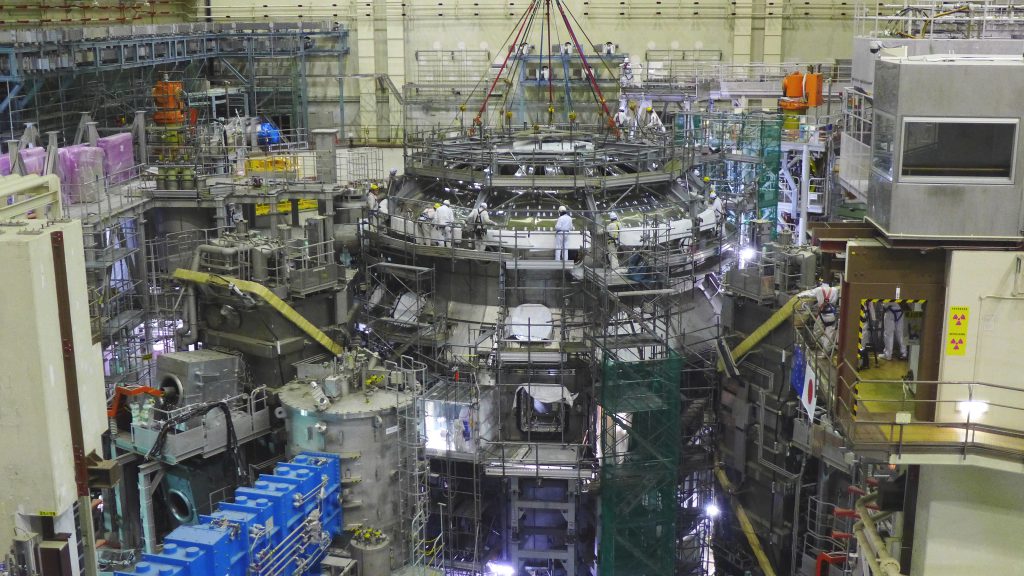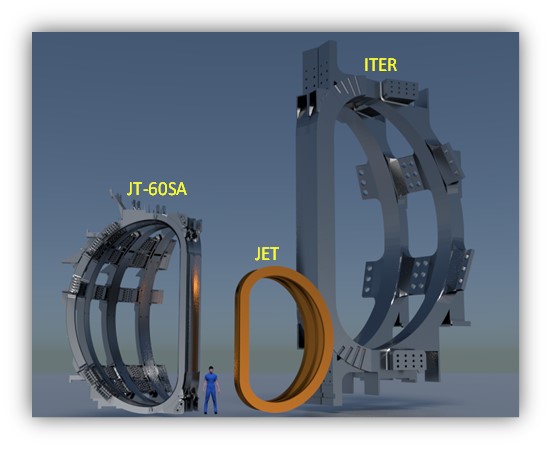Main Research Objectives of JT-60SA

The mission of the JT-60SA project is to contribute to the early realization of fusion energy by addressing key physics issues for ITER and DEMO.
JT-60SA, unlike ITER, will not operate by fusing deuterium and tritium, but instead use initially hydrogen and later deuterium to explore plasma behaviour. This allows the machine to become only minimally radioactive over its lifetime, allowing much more flexibility in the ways it can be reconfigured as experimental knowhow is gained.
JT-60SA has the performance capability that, if deuterium and tritium were to have been used, could allow it to reach or surpass “break-even”, where the power released by the fusion reactions, i.e. the produced power, would be equal to the heating power, i.e. the injected power. Learning how to reach this situation optimally on JT-60SA therefore will provide critical information for ITER operation, allowing ITER to go on to produce much more power than is injected.
To reach the appropriate operating conditions, confining high-temperature plasmas over long durations (up to about 100 sec), JT-60SA is equipped with superconducting magnets capable of generating powerful magnetic fields. The design of JT-60SA furthermore allows optimising the shape of the plasma (making it more elongated and more “triangular”) to increase the confinement.
JT-60SA will have up to 41 MW of heating power. This heating power will be provided by two different types of heating sources, targeting the electrons (Electron Cyclotron Resonance Heating) and the ions (Neutral Beam (NB) heating).
Thanks to its enhanced plasma confinement features, and its powerful heating systems, the machine will allow the exploration of ITER-relevant high density plasma regimes, well above the high-confined mode (H-mode) power threshold. These plasma regimes are important because they would allow the produced power to be maximised for a given injected power. In addition, the machine will have the capability to operate in different divertor configurations (both single and double null) to test different scenarios.
JT-60SA will allow studying power and particle handling for 100 sec high power discharges, with water-cooled divertors compatible with high heat fluxes (up to 15MW/m2).
In addition to studying how best to get to and beyond breakeven conditions, JT-60SA is designed to explore the potentially more power reactor-relevant (non-inductive) steady-state operation (as opposed to the pulsed operation characteristic of present tokamaks) and high beta plasma regimes.
JT-60SA is planned ultimately to be equipped with a remote handing system to allow maintenance of in-vessel components (compatible with the planned annual yield of 1.5×1021neutrons/year).
Complement to ITER
Even though JT-60SA has been developed independently, it has some similarities with ITER in terms of components or design processes:
- magnet conductor design and testing
- design of cryoplant
- in-vessel remote handling system
- ECRH and neutral beam heating/current drive systems
- project infrastructure: document management system, CAD system, QA
- the same implementing agencies: F4E (Europe) and QST (Japan)
- interlinked construction time schedules so as to be ready for complementary operation
| JT-60SA | ITER | |
|---|---|---|
| Major radius (m) | ~3.0 | ~6.2 |
| Minor radius (m) | <1.18 | <2.0 |
| Plasma current (MA) | <5.5 | <15 |
| On-axis toroidal field (T)/TF conductor | <2.3/NbTi | <5.3/Nb3Sn |
| Plasma elongation | <2.0 | <1.8 |
| Plasma triangularity | <0.5 | <0.5 |
| Plasma volume (m3) | ~140 | ~840 |
| Inductive pulse length (s) | 100 | >400 |

